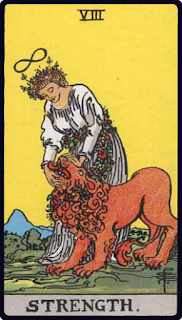
Worthy of note here, the Strength and Justice cards take positions 8 and 11 in the Rider-Waite deck and those derived from it, whilst other decks swap these positions to place Justice in the eighth position of the Major Arcana and Strength in the eleventh position.
Here Strength does not refer to physical strength but rather to strength of will, determination, reliability, and longevity. Strength has a particular focus on our willingness to commit to endeavours that may take time and patience and ask for much personal sacrifice to be made in order to assure their success.
In the upright state, Strength asks us to consider the possibility that our endeavours may take longer to achieve than we had first thought and to commit to the direction of travel more than the destination. Much like the Chariot which emphasised movement in any direction as a means to escape a situation, the Strength card emphasises the distance between us and our final destination and the stamina required in order to reach it.
In the inverted state, the Strength card asks us to look inward and consider our shortcomings, where the upright state places emphasis on the determination needed to see our efforts through to completion, the inverted state asks us to consider our capacity for patience and whether we have been too hasty in judging others or ourselves for not maintaining pace.
Our determination and self-confidence can be knocked by many external factors but the greatest source of doubt we will confront and be tasked with overcoming is that of our own mind the Devil in the religious sense therefore is asserted not to be an external force acting upon us but an influence already vested within us because of the concept of original sin; overcoming the devil within is the greatest struggle many of us will face in our lives - this concept foreshadowed here will return as a card in its own right in the form of The Devil later in the Major Arcana.
In the Rider-Waite deck, Strength is depicted by a woman in white holding the head of a lion in her hands. Lions are particularly notable amongst many big cats in their absence of their desire to hunt for sport; a lion hunts and kills for food, where food is not an imperative a lion will only stalk but will not kill, a lion does not kill when it has no need to kill unless it is threatened. The woman in white represents innocence and virtue and the lion in its passive state represents a threat at bay. When a cat is threatened or defensive its back arches upwards, here the lion’s back arches low representing submission, the lion is not threatened by innocence.
Finally, the infinity symbol above the woman’s head represents the infinite depth of patience required to confront the greatest threats and dangers we face in life with virtue. Although often interpreted simply as strength of will, the Strength card can also be interpreted as faith in our endeavours and inevitable success if patience is employed ultimately representing a call for us to trust that we will arrive where we are needed in time.
In self-reflection Strength can be a prompt to consider how much energy you will need to devote to an endeavour and consider whether the potential gain is worth the sacrifice. It can be useful here to reflect on the four domains once more, emotions, actions, thoughts, and physicality and consider the weight on each that our commitments make.
Strength serves as a reminder to be aware of the toll your choices have on you and to consider that with greater emphasis before making further commitments and to consider whether you are taxing yourself with those commitments you have already made. Where the Pope emphasised the question of whether we followed our routines out of devotion or expectation, the focus here is not on whether we want to do something but rather to be realistic when asking the question of whether we are capable of paying the toll.
Similarly, the Chariot asked us to consider what the alternatives were, even those we had originally dismissed, the focus here shifts away from the choice itself and instead focuses on the self and whether we are prepared to make those choices and deal with the consequences whether we can foresee them or not. Ask yourself “Is this worth it?” or “Do I have the energy for this?” or quite simply “Can I do this on top of everything else?”

No comments:
Post a Comment
All comments are moderated before they are published. If you want your comment to remain private please state that clearly.